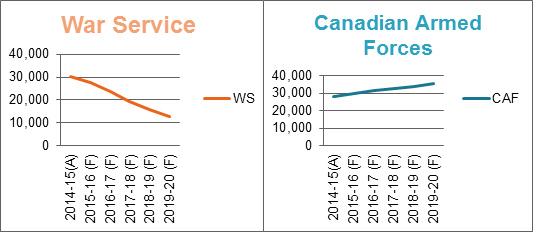3.1 Continued Need for the Program
There is a continued need for the Program.
As a result of injuries and aging, many Veterans and eligible civilians are no longer able to independently perform activities necessary to allow them to remain at home without assistance. The Program provides support to help individuals who want to remain healthy and independent in their homes and communities and delay, for as long as possible, the admission to a long term care facilityFootnote 18.
A trend of decreasing war service VeteransFootnote 19 and increasing Canadian Armed Forces (CAF) VeteransFootnote 20 is forecasted over the next five years. The war service population, the program’s original target population, is forecasted to decrease by 58% (from 30,430 in 2014-15 to 12,800 in 2019-20). However, an emerging and growing need was identified within the CAF population which is forecasted to increase by 26% (from 28,194 in 2014-15 to 35,400 in 2019-20)Footnote 21. As Figure 1 shows, although the number of war service Veterans using VIP will decline, an increase in need is forecasted for the Program within the CAF population. As the CAF population ages, a need for Program services will emerge among CAF Veterans and their primary caregivers.
Figure 1 – Actual and Forecasted Demand for the ProgramFootnote 22

Figure 1 – Actual and Forecasted Demand for the Program
| 2014-2015 (A) | 2015-2016 (F) | 2016-2017 (F) | 2017-2018 (F) | 2018-2019 (F) | 2019-2020 (F) | |
|---|---|---|---|---|---|---|
| War Service | 30,430 | 27,600 | 23,500 | 19,500 | 16,000 | 12,800 |
| Canadian Armed Forces | 28,194 | 29,700 | 31,300 | 32,700 | 34,100 | 35,400 |
* In Figure 1 above, “A” represents actual recipient population and “F” represents forecasted recipient population
Canadian home care trends show a large proportion of Canadians have unmet home care needs. “In 2012, 2.2 million individuals, or 8% of Canadians 15 years of age and older, received help or care at home because of a long-term health condition, a disability, or problems related to aging…of the 2.2 million Canadians who received home care in 2012, 15% (331,000) did not receive all the help needed”Footnote 23.
The average age of a CAF Veteran is 57 years oldFootnote 24. In its report, Canadians with Unmet Home Care Needs, Statistics Canada has highlighted that Canadians in this age group are being underserved by the health care systemFootnote 25. The Program helps to support Veterans in this age group whose needs may not be met through the provincial health care system.
No overlap or duplication was identified between the Program and provincial services.
Home care programs similar to VAC’s Program exist in each Canadian province. Although there are similar services offered by both VAC and the provinces, there are mechanisms in place to ensure there is no overlap in benefits. For example, the GDT takes into consideration provincial benefits provided for homecare and grounds maintenance and deducts these benefits from the total amount recipients’ are eligible to receive through the Program. Staff also indicated that there is no overlap or duplication in services provided by provincial home care programs and VAC’s Program.
3.2 Alignment with Government Priorities
The Program is aligned with the priorities and objectives of the federal government, as well as VAC, and with the strategic outcomes identified by the Department.
The October 2013 Speech from the Throne states, under Section 3: Putting Canada First – Supporting our Armed Forces, that the Government of Canada “…will always keep faith with those who have defended Canada with pride. Our veterans have stood up for us; we will stand by them”Footnote 26.
The Program addresses this Government of Canada priority as it provides services and supports that aim to help Veterans, their survivors, and their primary caregivers remain healthy and independent in their own homes and communities.
Economic Action Plan 2014 reaffirmed that the “Government of Canada is dedicated to honouring the sacrifices made by veterans and their families and ensuring that they receive the support they need”Footnote 27. The Program contributes to the support of Veterans’ independence and, thus, meets the objectives as outlined in the plan.
3.3 Alignment with Federal Roles and Responsibilities
The Program directly supports VAC’s mandate.
VAC's mandate stems from laws and regulations. Among the more significant is the Department of Veterans Affairs Act, which charges the Minister of Veterans Affairs with the following responsibilities:
"...the care, treatment, or re-establishment in civil life of any person who served in the Canadian Forces or merchant navy or in the naval, army or air forces or merchant navies of Her Majesty, of any person who has otherwise engaged in pursuits relating to war, and of any other person designated ... and the care of the dependents or survivors of any person referred to ..."Footnote 28.
The Program directly supports the mandate of Veterans Affairs Canada as it provides funding and services to support the independence and care of eligible Veterans in their homes and communities.
VAC identifies three strategic outcomes for the Department in the Strategic Outcomes and Program Alignment Architecture (PAA) section of the 2015-16 Report on Plans and Priorities:
- Financial, physical and mental well-being of eligible Veterans;
- Canadians remember and demonstrate their recognition of all who served in Canada’s efforts during war, military conflict and peace; and
- Veterans’ rights to services and benefits that address their needs are considered by Veterans Affairs PortfolioFootnote 29.
The Program supports Strategic Outcome #1 through the provision of financial grants and contributions towards services that contribute to the well-being and independence of Veterans.